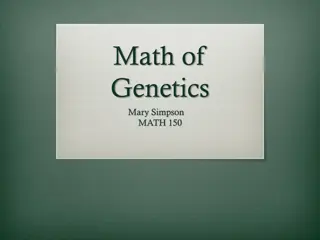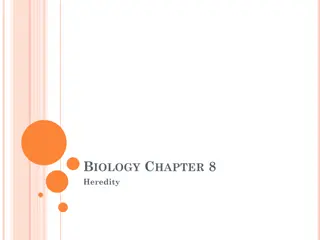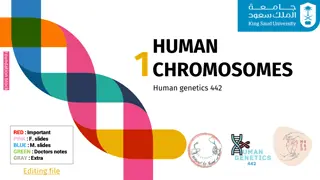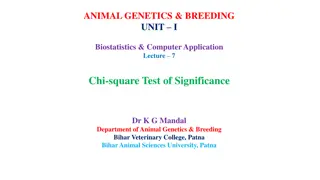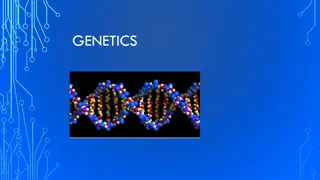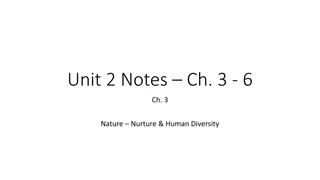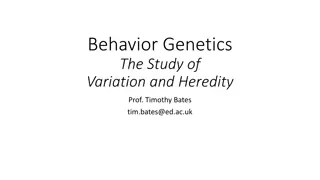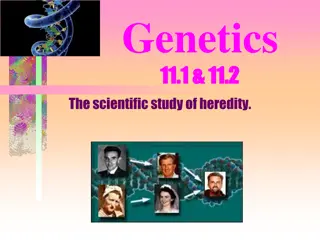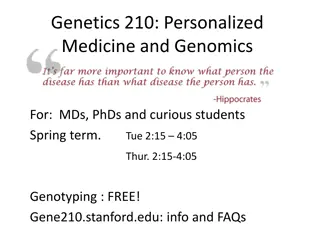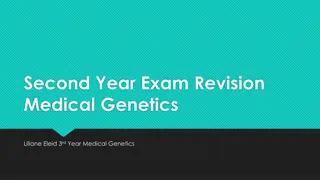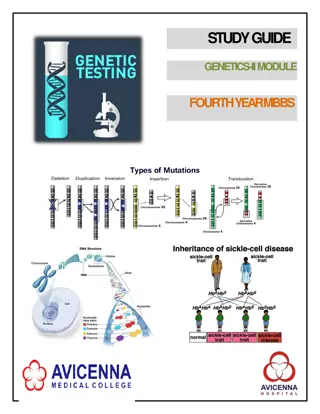Understanding Genetics: A Comprehensive Overview
Genetics is the study of genes, heredity, and variation in living organisms. This chapter explores key concepts such as phenotypes, genes, alleles, genotypes, and the laws of dominance. Through Punnett squares, the inheritance patterns of traits can be predicted, shedding light on how traits are passed from one generation to the next.
Download Presentation

Please find below an Image/Link to download the presentation.
The content on the website is provided AS IS for your information and personal use only. It may not be sold, licensed, or shared on other websites without obtaining consent from the author. Download presentation by click this link. If you encounter any issues during the download, it is possible that the publisher has removed the file from their server.
E N D
Presentation Transcript
Chapter 11: Genetics Mr. Freidhoff Biology
11.1: Genetics Phenotype: An organism s physical appearance due to the organism s genes. Examples: Eye color, hair color, height, hair length, etc.
11.1: Genetics Gene: The basic unit of heredity that occupies a specific location on a chromosome. Examples: Gene for eye color, Gene for hair color, etc.
11.1: Genetics Allele: Different versions of genes. Represent by a single letter (B, b, G, g). Examples: Brown eyes, blue eyes, green eyes, grey eyes
11.1: Genetics Genotype: An organism is the combination of alleles that are present in an organism s cells. Two alleles, two letters. Examples: BB, Bb, bb
11.1: Genetics Homozygous: Two identical alleles. Examples: BB, bb Heterozygous: Two different alleles. Example: Bb (Capital letter always comes first)
11.1: Genetics Dominant: Stronger of two genes expressed in the genotype. Capital letter (B). Recessive: Gene that is masked by the dominant gene. Lowercase letter (b).
11.1: Genetics Homozygous Dominant: Two dominant alleles. Examples: AA, BB, CC Homozygous Recessive: Two recessive alleles. Examples: aa, bb, cc Heterozygous: One dominant, one recessive. Examples: Aa, Bb, Cc
11.1: Genetics Law of Dominance When the dominant allele is present, the dominant phenotype will be produced. When both recessive alleles are present, the recessive phenotype will be produced.
11.2: Punnett Squares Organisms have two versions of every gene. Meiosis creates sex cells with one version of a gene.
11.2: Punnett Squares Punnett Square: A tool we use for predicting the traits of an offspring. Boxes represent possible offspring. Alleles on top and side represent parents.
11.3: Mendel Generations: P = Parental generation. F1 = 1st Generation Offspring of the P generation. F2 = 2ndGeneration Offspring of the F1 generation.
11.3: Mendel P-Generation Crossed purple flower plants with purple flower plants until no white flowers were in offspring. Crossed white flower plants with white flower plants until no purple offspring were in offspring. Called true breeding
11.3: Mendel F1 Generation Crossed True breeding purple flower pea plant with True breeding white flower pea plant. Offspring was all purple flower. Crossing = Mating
11.3: Mendel F2 Generation Crossed two purple flowers from the F1 generation. 3/4 of offspring were purple 1/4 of offspring were white
11.3: Mendel P Generation Purple: AA White: aa F1 Generation Purple: Aa F2 Generation Purple: AA, Aa White: aa
11.4: Pedigrees Pedigree: Family tree that records and traces the occurrence of a trait.
11.4: Pedigrees Males are squares. Females are circles. Shaded in people have trait.
11.4: Pedigrees Carrier: Individual who has one copy, but doesn t have the disorder. Carriers are half shaded in.
11.4: Pedigrees Lines between individuals represents the couple having an offspring. Circles and Squares below are offspring.
11.4: Pedigrees Recessive Traits/Disorders: Individuals who have trait are shaded in and are homozygous recessive. If AA and Aa are possible, correct answer is A? Question marks CAN be ONLY correct answer.
11.4: Pedigrees Dominant Traits: Individuals have at least ONE dominant allele. Can be AA or Aa. No Carriers. If AA and Aa are possible, correct answer is A?
11.5: Codominance vs. Incomplete Incomplete Dominance Heterozygotes have a phenotype that is intermediate between the phenotypes of the two homozygotes. Neither allele is dominant or recessive. Sometimes written with superscript. AKA: Intermediate Dominance
11.5: Codominance vs. Incomplete Codominance: Situation in which both alleles of a gene contribute to the phenotype of the organism. Expressed with capital letters.
11.6: Blood Genetics A person s blood type is regulated by multiple alleles and codominance. 3 Different Alleles types. A, B, O 4 different phenotypes: A, B, AB, O
11.6: Blood Genetics In humans, blood types A and B are equally dominant. A = B A and B blood are dominant to O. AB > o
11.6: Blood Genetics Genotypes: A Blood: AA, Ao B Blood: BB, Bo AB Blood: AB O Blood: oo
11.6: Blood Genetics Type O is the universal donor. No Antigens to react with. Type AB blood is universal receiver. No Antibodies to react with foreign blood.
11.6: Blood Genetics Rh Factor More antigens. Positive (+) represents presence of antigens. Negative (-) represents no antigens. Positive: + + or + - Negative: - -
11.7: Sex-Linked Genetics Sex Chromosomes: 23rd pair XX: Female XY: Male X: 1500 genes Y: 80 genes
11.7: Sex-Linked Genetics Sex-linked Gene: Any gene that is located on a sex chromosome. In humans, most sex-linked genes are found on the X- Chromosome. Typically recessive disorders.
11.7: Sex-Linked Genetics Males only need 1 copy of a sex-linked disorder on a X-chromosome to produce the phenotype. Males inherit x-linked disorders more than females.
11.7: Sex-Linked Genetics Females need two X- chromosomes with disorder. Carrier: Individual who has one copy, but doesn t have the disorder.
11.8: Polygenic Inheritance Several Alleles contribute to phenotype. Large amount of phenotypes. Most of human genetics fall under polygenic inheritance.


